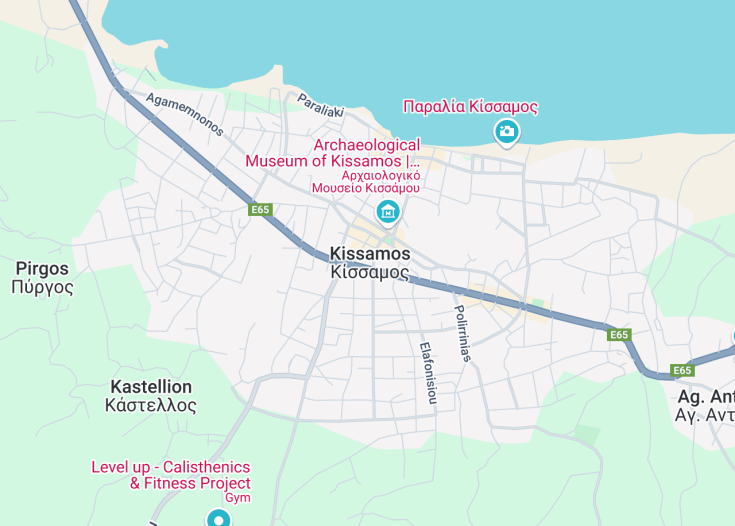Kissamos, nestled on the western edge of Crete, Greece, enchants visitors with its blend of historical richness and serene natural beauty. This charming town is fringed by exquisite beaches and steeped in millennia of history, evident in its archaeological sites and traditional architecture.
It serves as an ideal base for exploring the renowned Balos Lagoon and the ancient city of Polyrinia. Kissamos combines its vibrant cultural heritage and stunning Greek landscapes to offer a unique holiday experience far from the typical tourist trails.
Ensure to visit the Kissamos Archaeological Museum to gain a deeper appreciation of the area’s historical significance and to view artifacts dating back to the Minoan period.
Pack comfortable footwear as exploring the historical sites and beautiful terrains of Kissamos involves a fair amount of walking.
Top things to do & see in Kissamos
Select the following sights and activities to discover best tickets and tours available in Kissamos.
Kissamos: A Jewel of the Cretan Coast
| Country | Greece |
| Time in Kissamos | GMT+2 |
| Language spoken | Greek |
| Population | 4,912 (source: Hellenic Statistical Authority, 2021) |
| Currency | Euro (€, EUR) |
| Airports |
|
Kissamos, positioned on the western tip of Crete, Greece, flourishes with rich history and breathtaking scenery. This small town, sometimes referred to as Kastelli-Kissamou, is a destination enriched with a deep-rooted history dating back to ancient times. Ancient Kissamos was a prominent and wealthy city during the Roman and Byzantine era, known for its wine and olive oil production. Today, it’s celebrated for its quaint harbors, pristine beaches, and archaeological sites that offer a glimpse into its magnificent past.
The town serves as an ideal base for exploring western Crete’s landmarks, including the famous Balos Lagoon and Elafonissi Beach, noted for their stunning pink sands and crystal-clear waters. Kissamos also prides itself on its preserved Venetian architecture seen throughout the town and at the well-conserved Venetian fortress at Gramvousa.
Culturally, Kissamos harbors a vibrant tradition in the arts, particularly in its local dance and music. The annual ‘Kissamos Festival’ showcases local music, dance, and food and draws visitors from all around. The town’s economy is primarily based on agriculture, with olive oil and wine production being the most significant, alongside growing tourism which has seen the proliferation of cozy tavernas, cafes, and small guesthouses.
For culinary enthusiasts, Kissamos offers an array of traditional Cretan dishes, with tavernas serving everything from dakos (a traditional Cretan salad) to fresh seafood straight from the coastal waters. The local cheese, michéri, made from sheep and goat milk, is a must-try delicacy.
Kissamos is not only about relaxation and culinary delights; it also offers adventurous activities like hiking, cycling, and bird watching. The rich natural landscape of the region makes it perfect for these activities, with various trails leading to ancient sites and secluded beaches.
Where is Kissamos?
Kissamos is located in the picturesque northwest of Crete, Greece, enveloped by the azure waters of the Mediterranean Sea.
Distances:
| Route | Distance by car | Time by car |
| Athens to Kissamos | 435 mi | 9 hours |
| Chania to Kissamos | 24 mi | 40 minutes |
| Rethymnon to Kissamos | 72 mi | 1 hour 55 minutes |
What is Kissamos famous for?
Kissamos is renowned for its beautiful beaches like Balos and Elafonissi, its rich history reflected through numerous archaeological sites, and traditional Cretan culture.
History
Ancient Era: Before 365 AD
The region of Kissamos, situated on the western edge of Crete, Greece, has a long and vibrant history that extends far back into antiquity. Archaeological evidence suggests that Kissamos was inhabited thousands of years ago, initially by Minoan civilizations, renowned for their advanced culture and the oldest of Europe’s recorded civilizations. During these early periods, Kissamos was primarily a prosperous port town playing a crucial role in trade across the Mediterranean. Its strategic location on Crete’s coast made it a central hub for exchanging goods and cultures between different civilizations such as the Greeks, Romans, and Phoenicians. Over time, it flourished under Roman rule becoming an important city by the name of Cisamos.
Byzantine and Venetian Rule: 365 AD – 1699
Following the division of the Roman Empire, Kissamos fell under Byzantine control. During this era, it continued to prosper, but also faced numerous pirate invasions, leading to fortifications being built around the city. In 1204, with the fall of Constantinople, Crete passed into the hands of the Venetians. During Venetian occupation, Kissamos was further fortified, with massive walls and towers still visible today, showcasing the blend of Venetian architectural styles with existing Byzantine structures. The town was an important naval base and saw many battles, especially against the Ottoman Turks who attempted to conquer Crete several times.
Ottoman Rule to Modern Era: 1699 – Present
The city of Kissamos fell under Ottoman rule in 1699 after the fall of Venetian Crete. This period was marked by several rebellions as the locals fought against Ottoman oppression. In 1898, Crete gained autonomy, and finally, in 1913, it became part of Greece. The 20th century was a challenging time for Kissamos, as it faced the adversities of World War II and the German occupation, but it emerged resilient. Today, Kissamos is a captivating blend of its rich historical past and modern Greek culture. It is celebrated not only for its extraordinary historical sites but also as a vibrant community with deep-rooted traditions and a picturesque landscape that draws visitors from around the world.
Visit Kissamos
What to see and do in Kissamos, Greece
Kissamos, often cloaked in historical significance, offers a plethora of activities and sights for the discerning traveler. Visitors can explore ancient ruins, such as the well-preserved Roman and Venetian fortifications, which provide a glimpse into the town’s multi-layered history.
The Archaeological Museum of Kissamos showcases artifacts that span the entirety of the region’s past from Minoan to Roman eras.
- Stroll along the scenic beaches like Balos Lagoon and Falassarna, each offering breathtaking views and crystal-clear waters.
- Visit the ancient city of Polyrinia, one of the oldest cities, which provides a panoramic view of the surrounding area.
- Taste local Cretan cuisine in traditional tavernas that dot the landscape.
- Engage in outdoor activities such as hiking the rugged trails or kayaking along the Kissamos coast.
Festivals and Events in Kissamos
Kissamos hosts a variety of cultural events and festivals throughout the year, which reflect its rich tradition and vibrant community life. Key events include the summer “Kissamos Festival” which features live music, dance, and local cuisine.
The “Sardine Festival” is another highlight, celebrating the region’s fishing heritage with plenty of fresh sardines, wine, and entertainment, typically held in August.
Best time to visit Kissamos
The ideal time to visit Kissamos is between late spring and early autumn, from May to October, when the weather is warm and sunny, perfect for beach activities and cultural festivals.
Is Kissamos worth visiting?
Kissamos is undoubtedly worth visiting. With its rich tapestry of history, stunning natural beauty, and vibrant cultural scenes, this charming town offers a unique blend of experiences that cater to all types of travelers.
Whether you’re a history enthusiast eager to explore ancient ruins, a nature lover in search of serene landscapes, or a culture-seeker looking to immerse in local traditions, Kissamos promises a fulfilling and enriching escape.









